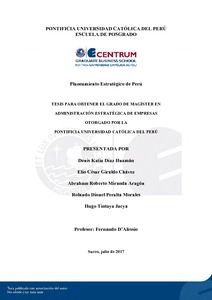| dc.contributor.advisor | D’Alessio Ipinza, Fernando Antonio | |
| dc.contributor.author | Díaz Huamán, Denis Katia | es_ES |
| dc.contributor.author | Giraldo Chávez, Elio César | es_ES |
| dc.contributor.author | Miranda Aragón, Abraham Roberto | es_ES |
| dc.contributor.author | Peralta Morales, Rolando Dionel | es_ES |
| dc.contributor.author | Tintaya Jacya, Hugo | es_ES |
| dc.date.accessioned | 2017-07-18T01:39:35Z | |
| dc.date.available | 2017-07-18T01:39:35Z | |
| dc.date.created | 2017 | |
| dc.date.issued | 2017-07-18 | |
| dc.identifier.uri | http://hdl.handle.net/20.500.12404/9075 | |
| dc.description.abstract | Se ha desarrollado el planeamiento estratégico para el Perú, utilizando la metodología
denominada Proceso Estratégico y que fue creada por D’Alessio (2015). Este país se
encuentra ubicado en el centro occidente de América del Sur, con acceso a importantes
mercados de Asia y de América Latina, así como a Estados Unidos. El Perú está organizado
en 24 regiones y una provincia constitucional, que a su vez se dividen en provincias y
distritos, albergando a más de 31 millones de habitantes, población que crece al 1.3% anual.
A pesar de contar con grandes recursos naturales, el Perú se ha enfocado en la producción y
exportación de bienes primarios, como minerales, frutas y verduras. Pero es necesario que se
haga más énfasis en la manufactura de estos productos, para no depender de los precios
internacionales de commodities. Así se hará frente a las amenazas del entorno, como
desaceleración económica en los principales mercados del mundo, utilizando fortalezas como
los acuerdos y tratados comerciales que se han establecido. Para el año 2030, el Perú será la
segunda economía en América del Sur, y lo logrará mediante la implementación de las
siguientes estrategias: : (a) diversificar el puerto del Callao; (b) penetrar en el mercado de
atención a buques y movilización de carga en contenedores secos y refrigerados; (c)
diversificar la oferta turística; (d) penetrar en el mercado norteamericano de frutas y verduras;
(e) desarrollar productos agroindustriales; (f) integrarse verticalmente hacia adelante
estableciendo distribuidores en los principales mercados que se abastecen de productos
agrícolas, café y té peruano, entre otros bienes; (g) desarrollar los nuevos proyectos mineros;
(h) desarrollar vías de comunicación terrestre para conectar las distintas ciudades del país con
las fronteras, así como con los puertos y aeropuertos; (i) desarrollar servicios de educación
secundaria para áreas rurales; (j) integrarse con organismos multilaterales para aumentar la
inversión en ciencia y tecnología; y (k) continuar desarrollando la descentralización y el
trabajo cooperativo entre distritos, provincias y regiones | es_ES |
| dc.description.abstract | This strategic planning has been developed for Peru, using the methodology called Strategic
Process which has been created by D'Alessio (2015). This country is located at the center of
South America, with access to important markets in Asia and Latin America, as well as the
United States. Peru is organized in 24 regions and a constitutional province, which in turn are
divided into provinces and districts, housing more than 31 million inhabitants, a population
that grows at 1.3% per year. Despite having large natural resources, Peru has focused on the
production and export of primary goods, such as minerals, fruits and vegetables. But more
emphasis needs to be placed on the manufacturing of these products, so as not to depend on
international commodity prices. This will address the threats of the environment, such as
economic slowdown in the main markets of the world, using strengths such as agreements
and trade agreements that have been established. By 2030, Peru will be the second economy
in South America, which will be achieved through the implementation of the next strategies:
(a) diversify the port of Callao; (b) penetrate the market for ship-handling and cargo
mobilization in dry and refrigerated containers; (c) diversify the tourism supply; (d) penetrate
the US fruit and vegetable market; (e) developing agro-industrial products; (f) integrate
vertically forward by establishing distributors in the main markets that are supplied with
agricultural products, coffee and Peruvian tea, among other goods; (g) develop new mining
projects; (h) to develop terrestrial communication ways to connect the different cities of the
country with the borders, as well as with the ports and airports; (i) develop secondary
education services for rural areas; (j) integrate with multilateral agencies to increase
investment in science and technology; and (k) continue to develop decentralization and
cooperative work among districts, provinces and regions | es_ES |
| dc.language.iso | spa | es_ES |
| dc.publisher | Pontificia Universidad Católica del Perú | es_ES |
| dc.rights | info:eu-repo/semantics/openAccess | es_ES |
| dc.rights.uri | http://creativecommons.org/licenses/by-nc-nd/2.5/pe/ | * |
| dc.subject | Planificación estratégica -- Perú | es_ES |
| dc.title | Planeamiento estratégico de Perú | es_ES |
| dc.type | info:eu-repo/semantics/masterThesis | es_ES |
| thesis.degree.name | Maestro en Administración Estratégica de Empresas | es_ES |
| thesis.degree.level | Maestría | es_ES |
| thesis.degree.grantor | Pontificia Universidad Católica del Perú. CENTRUM | es_ES |
| thesis.degree.discipline | Administración Estratégica de Empresas | es_ES |
| renati.advisor.dni | 41319855 | |
| renati.advisor.orcid | https://orcid.org/0000-0002-4242-1220 | es_ES |
| renati.discipline | 413307 | es_ES |
| renati.level | https://purl.org/pe-repo/renati/level#maestro | es_ES |
| renati.type | https://purl.org/pe-repo/renati/type#tesis | es_ES |
| dc.publisher.country | PE | es_ES |
| dc.subject.ocde | https://purl.org/pe-repo/ocde/ford#5.02.04 | es_ES |






